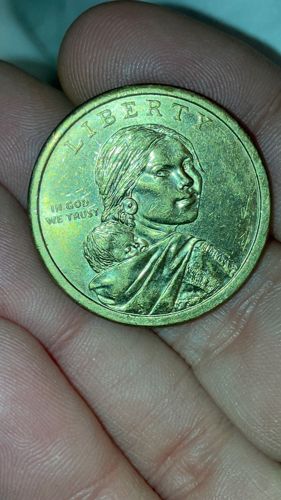Sacagawea Dollar (Native American Dollar Series)
Country of Origin: United States
Year of Issue: 2000-Present (specific year not visible, but design is from series)
Denomination: One Dollar
Composition: Manganese brass clad (88.5% copper, 6% zinc, 3.5% manganese, 2% nickel)

Brief Description
The obverse features Sacagawea looking right, with her infant son Jean Baptiste Charbonneau on her back. The word "LIBERTY" is above her, and "IN GOD WE TRUST" is to her left. The coin has a golden color.
Historical Significance
The Sacagawea Dollar, also known as the 'golden dollar,' was introduced in 2000 to replace the Susan B. Anthony dollar. It honors Sacagawea, a Shoshone woman who helped the Lewis and Clark Expedition explore the Louisiana Purchase. The initial design (as seen in the image) featured Sacagawea and her child, symbolizing her role in American history and her native heritage. Later issues in the Native American Dollar Series feature rotating reverse designs, but the Sacagawea obverse remains consistent.
Estimated Value
Circulated Sacagawea dollars are typically worth their face value ($1) due to their widespread availability. Uncirculated or proof examples, especially from certain years or with specific mint marks, can be worth slightly more, ranging from $2 to $10 or more depending on condition and rarity. Errors or varieties can significantly increase value.
Care Instructions
To preserve the coin's condition and value, handle it by its edges to avoid transferring oils from your skin. Store it in a cool, dry place in an inert holder, such as a Mylar flip or a non-PVC coin slab. Avoid cleaning the coin, as this can damage its surface and significantly decrease its numismatic value.
Created At: 2025-11-18T01:52:47.014178